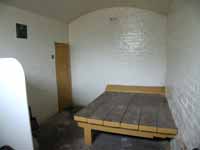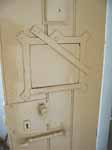![]()
THE ADMINISTRATION OF LAW & ORDER
Anglo-Saxon times
From the 10th century Bingham was sufficiently important to be the meeting place for the Wapentake (Hundred) of Binghamshou. From then until 1974, Bingham district remained an administration area for local government (Bingham Rural District Council in recent times) and for the administration of local justice until the late 1980s, when the work of the Bingham Magistrates’ Court was centralised first to the Shire Hall in Nottingham and in 1995 to the new combined Magistrates’ Court at Carrington Street, Nottingham.
Of historic interest is the Moothouse Pit alongside the A46, just south of the Saxondale roundabout. Adelaide Wortley’s History of Bingham, 1954 describes “an old English moot dealing with criminal law had its chairman (king or alderman) committee (sworn witnesses of grand jury) speakers and seconders (plaintiff and defendant with witnesses and bailmen). Proof was taken by ordeal of fire or water. The Courts were held in the open air, generally on a hill where all could see and hear as was Bingham’s Hundred Court.”
The Eyre Court
By the 12th century, the Eyre Court dealt with the serious crimes. There was an Eyre Court in every County taken by one of the Kings Judges who travelled to the County regularly. A jury of twelve men from each Hundred brought any case or legal problem to the Eyre Court which could not be dealt with by the local courts (see Hue & Cry). The Eyre Court developed in three directions to deal with different degrees of seriousness of case. The Assize Court presided over by a High Court Judge sitting at the Shire Hall, dealt with the most serious cases. Sessions heard middling serious cases dealt with by the Chairman of Quarter Session (a local Judge). A panel of Justices of the Peace, sitting at larger centres in the County ( e.g. Newark) heard lesser cases. In 1972 all were subsumed into the Crown Court, which now sits at Canal Street, Nottingham.
Sheriff
The office of Sheriff dates back at least to 950AD. In his judicial capacity the Sheriff had two courts, the tourn and the county courts; the former a criminal and the latter a civil court. The tourn court was attended by the freeholders of the county who enquired into various offences that took place in the county and into nuisances, weights and measures and so forth. The power of the Sheriff to try presentiments made by the town was taken away by the Magna Carta and subsequently by Edward I.
The Sheriff presided over the county court and all freeholders of the county had the right to attend either as judges or suitors. In this court were decided various suits of a civil nature, whether for trespass or debt, where the amounts were small. In the county courts were elected the knights of the shire, the coroner and the verderers. Proclamations made, whether from the crown or from the courts (e.g. outlawry), and any other business of the county were also transacted.
A sheriff derived considerable profit from his office arising partly from the sums received by him through his courts, which, in this, as other cases, yield other profit to those who had a right to them and, partly, from what would now be termed "percentages" on the moneys he collected from the crown; extortion was paramount. One example was the holding of a court at an inconvenient time and place then fining all those who did not attend. The fines, of course, were paid into the Sheriffs coffers.
Justices of the Peace
In the later medieval period the Anglo-Saxon community-based system of law enforcement was gradually undermined by the creation of a new local official: the Justice of the Peace, or JP. JPs were:
1. appointed by the king, not the local community.
They were thus part of central government (royal) power, which increased
through the later Middle Ages.
2. appointed because of their local power, wealth and rank.
The 15th century baronial wars known as the Wars
of the Roses, and the 17th century Civil War, led the population of England
to be highly suspicious of soldiers and to loathe the idea of a special
force of lawmen. This left a large part of crime prevention up to the
individual, as it had been in Anglo-Saxon times. If you were robbed, you
had to find out who did it and take the person to court yourself. However,
by the 17th century the Justices’ role had developed to embrace:
a) Summoning offenders to be brought before them and binding them over
to good behaviour or causing them to appear at Quarter Sessions
b) Being informed of murders, felonies and “outrages” in their
district
c) Making orders in bastardy, which were afterwards confirmed at Quarter
Sessions
d) Calling not only the village constable before them but also the Churchwarden
and overseers to enquire into the working of the statutes, which they
had to administer concerning rogues and vagabonds
e) Setting the poor to work and binding children apprentices.
Single Justices of the Peace sat at their own house and administered poor relief (to mitigate harshness of parish offices), examined mothers of bastards and the source of origin of doubtful strangers, took “a view of highways”, presenting offending parishes and restrained morals by fining for the offence of swearing (at 1 shilling a time) or profaning the Sabbath or tippling in alehouses!
Manor courts
By the time of Elizabeth 1, manor courts attempted to control local anti-social behaviour together with Justices of the Peace. The important persons in the Manor Court were the Lord of the Manor and the Rector. The Bingham Manor Court met by the church gates. Later, the Court moved into what is now the Chesterfield Arms until in 1852 the Police Station was built with its Court Room and cells inside (Now The Old Court House, Church Street).
 The prison cell at the rear of the Old Court House now contains the original plank bed and a modern toilet behind the screen on the left. Photo: Robin Aldworth |
 The Old court House in Church Street, built in 1852 as a court house, with prison cells and quarters for the police officer. It is now the offices of Bingham Town Council. Photo: Robin Aldworth |
 The door to the prison cell with the original lock and the viewing slot, now sealed up. Photo: Robin Aldworth |
For centuries, therefore, the administration of law was confined to an area of about 25 metres from the Church gate!! At least, until a County Court, dealing with disputes between subjects, as opposed to criminal acts said to be against the state, was established in a building that stood at the corner of Market Street and Market Place. (The building was also home to the Excise Office and the Fire Office). There is now a separate Police Station on Grantham Road and Fire Station on Long Acre. In 1998 the Old Court House was acquired by the Bingham Town Council for use as the Town Office and Council Chamber.
Arrangements for the poor
The Parish of Bingham’s arrangements for the poor developed as an attempt to control crime, feckless unemployment and anti-social behaviour. It is clear that for many years the poor of Bingham were housed in special accommodation and there are records of three such institutions. The first “lock up” (prison) (not strictly limited to housing the poor) was in Moor Lane. There are also records of a parish workhouse in Moor Lane from the early eighteenth century. The Union “Model” workhouse was built on Nottingham Road in 1837. Bingham’s “Model” workhouse was for its time the pilot scheme for a “deterrent workhouse” and was set up under the Poor Law Amendment Act 1834 put through Parliament by the Home Secretary and, amongst, others, Robert Lowe, the son of Reverend Robert Lowe of Bingham, and later Chancellor of the Exchequer. For an example of life in the Workhouse see “Christmas in the Workhouse” in “Old Nottinghamshire Remembered”.
